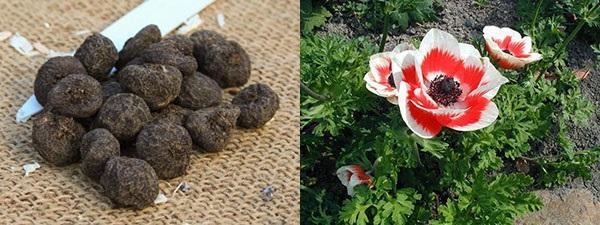What you need to know about how to grow anemones?
 The bright color of the delightful flowers attracts many gardeners so much that they buy them without question. However, many are wondering how to grow anemones, because in most cases these crops do not germinate. Therefore, it is worth finding out why this happens and what to do then.
The bright color of the delightful flowers attracts many gardeners so much that they buy them without question. However, many are wondering how to grow anemones, because in most cases these crops do not germinate. Therefore, it is worth finding out why this happens and what to do then.
Before buying, pay attention to the condition of the tubers. If they are too wrinkled, hard like a stone and of an incomprehensible shape, then they are overdried. The probability of their germination is not great. Moreover, small specimens do not bloom at all in the first year.
How to grow anemones?
It is recommended to deal with such delicate flowers closer to spring. Lack of light leads to the fact that the plant is actively stretched. Then it is not able to give abundant flowering. At the same time, all nodules should be soaked before planting. If the roots are simply poured with water and insisted for a day, they will simply suffocate. Therefore, they take:
- a napkin or piece of cloth;
- cover the bottom of the container with it;
- pour on it a little solution of fungicide or growth stimulant ("Zircon»);
- planting material is placed on paper;
- cover with a dry napkin;
- wrap the container with a film;
- after 2-3 hours, after they swell, stretch.
Such a humid environment will help the tubers to straighten out and show the gardener which side of their stem grew. After soaking, the culture is advised to immediately be planted in a small pot. Thus, from March to May, the plant will reach seedling state. But how do you grow anemones so that they are productive? You need to create suitable conditions for them:
- temperature - not higher than + 16 ° С;
- humid, not hot or dry, air;
- daylight hours from 12 hours or more.
Some people install special lamps so that the sprouts receive enough light. Then, thanks to full-fledged photosynthesis, they will receive a sufficient supply of carbohydrates, which is needed for successful growth.
To check how "young" the anemone tubers are, you need to dip them into water. If they come up, then they are over 2 years old. Then they are not suitable for planting. Although some gardeners manage to plant them separately from others.
The subtleties of the trade
Many people complain that they follow all the planting rules, and the result is poor. The reason for this is the shortcomings in trade. Suppliers bring an excess amount of planting material to each region. Entrepreneurs do not have time to sell it in a season. As a result, they remain for the next year, repackaged and stored in warehouses. And there unsuitable conditions are created for them, because of which the products dry out greatly. The germination capacity of such specimens is reduced by five times. Then growers buy these "dying" tubers, which have undergone additional exposure, and are unaware of it. Sadly, then they are looking for an answer to the question of how to grow anemones so that they do not disappear.